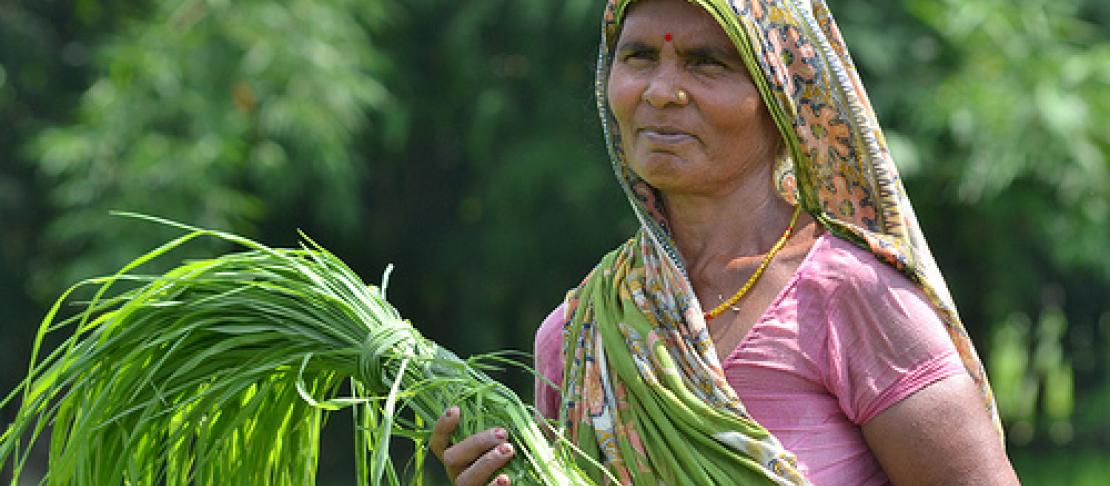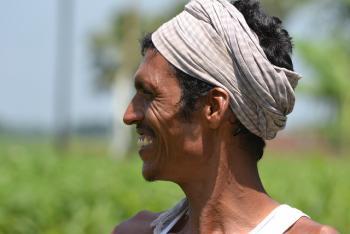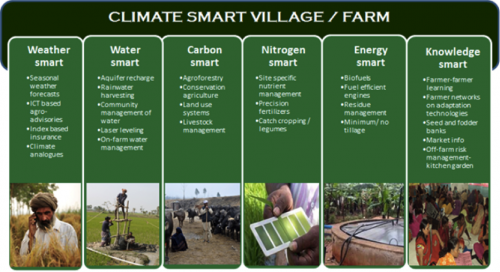Climate smart villages in India show early signs of great reform achievements

by PK Aggarwal, GD Bhatta, PK Joshi, SA Prathapar, ML Jat, P Mathur and M Kadian
Recently, the CGIAR Research Program on Climate Change, Agriculture and Climate Change (CCAFS) introduced the model of ”Climate Smart Villages (CSVs)”. The idea was to raise awareness among farming communities in South Asia about various technological, institutional and policy-oriented options that have the potential to increase their climatic resilience, adaptation, agricultural productivity and income, while reducing emissions of greenhouse gases.
Interventions that were made, related to weather, water, carbon, nutrient, energy and knowledge management, are currently being evaluated by the farming communities in a participatory way.
The villages, initially started in South Asia, are now being replicated at other CCAFS regions in East and West Africa. They are very different from for example the United Nations Development Program’s millennium villages, which are based on a science-led partnership between academia, business and UN agencies to achieve the Millennium Development Goals (MDGs).
These villages were set up in Africa with considerable financial investment. Instead, our climate-smart villages have as a key focus to enhance climate literacy of farmers in developing countries of South Asia and Africa, with little financial investment.
The farmers are now evaluating the elements of value-added from weather forecasts; ICT based agro-advisories; index based insurance; seed and fodder banks; efficient irrigation management strategies; adapted cultivars; conservation agriculture based management practices; and a range of other low GHG emitting options.
It is also proposed to facilitate farmer exchange visits across the climate analogue sites for their increased mutual learning about future adaptation strategies.

In addition, rural women leaders are being especially trained to increase their awareness about options that can accelerate adaptation. Disseminating value-added agro-advisories, index-based insurance products and related agro-information through mobile phones is helping to reach farmers even beyond the core villages. Rural fairs and farmer participatory videos are being used to upscale the activities throughout.
The climate-smart villages actually provide an early example related to success of the CGIAR reform process of highlighting the inter-centre collaboration and synergies for addressing the agricultural problems.
Let us take the example of these villages in Vaishali district of Bihar in India. CCAFS South Asia identified study regions for establishing the villages and invited various CG centres and other partners to join in. A developmental NGO facilitated the formation of farmers’ communities for this project.
Watch a video from the climate smart village project:
In the project, the International Food and Policy Research Institute (IFPRI) is prioritising adaptation and mitigation options using a simple cost/benefit analysis, whereas the International Water Management Institute (IWMI) is addressing the issues of seasonal waterlogging through vertical drains.
CIMMYT is providing knowledge base for conservation agriculture based crop management technologies and precise use of fertiliser nutrients. Bioversity International and the International Potato Center (CIP) are evaluating crop germplasm and varieties with farmers’ direct participation.
Crop diversification is implemented by National Research partners (NARS). Private sector partners are providing rainfall and temperature insurance and in collaboration with Indian Meteorological Department are providing cell phone based voice messages about weather, agricultural systems, market prices, and other related information.
Other developmental NGOs facilitates up-scaling by organising periodic rural fairs, capacity building of farmers, especially rural women leaders, and supporting farmers video production and dissemination.

The initial feedback indicates that famers and other stakeholders really enjoy and benefit from this interactive, packaged, and participatory approach. We hope that this partnerships, and other similar to it across the CGIAR centres, farmers, NARS, and private sector will lead to the accelerated attainment of the CGIAR goals towards increased food security, poverty alleviation and climatic resilience.
Read more about CGIAR and its 15 global research programs.
This story was written by PK Aggarwal, Regional Program Leader South Asia, GD Bhatta, Science Officer South Asia, PK Joshi, Director, South Asia, IFPRI - New Delhi, SA Prathapar Theme Leader - Productive Water Use, IWMI - New Delhi, ML Jat Cropping Systems Agronomist, CIMMYT - New Delhi, P Mathur, Senior Scientist and South Asia Coordinator, Bioversity International – New Delhi, M Kadian, Lowland Potato Leader for SWCA, CIP. This story was edited by Cecilia Schubert.

